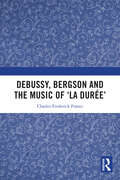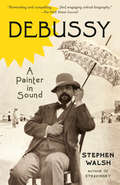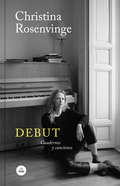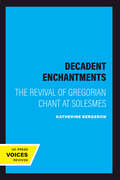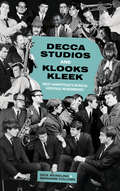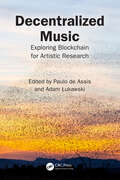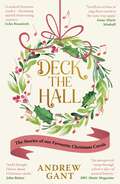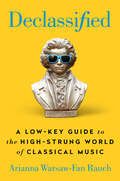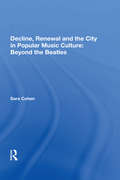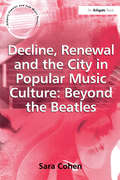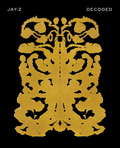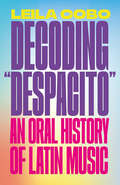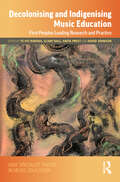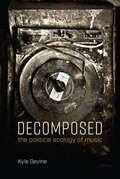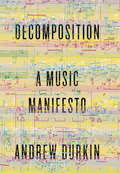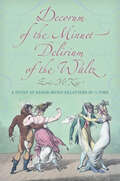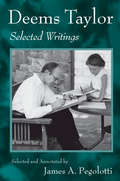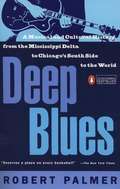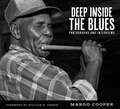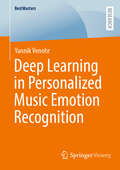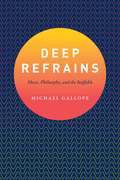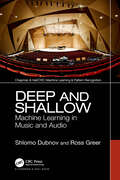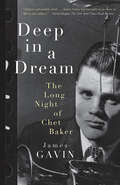- Table View
- List View
Debussy, Bergson and the Music of 'la duree'
by Charles FrantzCharles Frederick Frantz provides a quantitative and qualitative analysis of Debussy’s music through the lens of Bergson’s philosophical perspective of durée, revealing his "revolution" in musical time.In fin-de-siècle Paris, Debussy was revolutionizing musical time while Bergson was establishing a metaphysics that challenged the notion of measured or spatialized time. Bergson argued that real time or durée could be grasped only through intuition as opposed to analysis. Debussy eschewed analysis of music, declaring that separating it into parts was better left to engineers. Debussy’s music and Bergson’s durée were conceived and imagined in the environs of nature. The cycle of seasons, the gracefulness of a blooming flower, or a gentle breeze all suggest continuity, flow, and uninterrupted rhythm. The time of nature is the time of Debussy’s music and Bergson’s durée. Debussy’s use of open forms and Golden Sections create a time world of an expanded present, never ceasing. Bergson’s perception of real time is ever-changing, bringing the past into the present and open to unforeseen novelty.This book is intended primarily for scholars in the disciplines of musicology, music theory, and philosophy and can be used as a text for upper-level undergraduate or graduate courses in musicology or music theory.
Debussy: A Painter in Sound
by Stephen WalshA beautifully written and original biography of one of the greatest and most popular of modern composers--which also deeply investigates his much-loved music.Claude Debussy (1862-1918) was that rare creature, a composer who reinvented the language of music without alienating the majority of music lovers. The creator of such classics as La Mer and Clair de Lune, of Pelléas et Mélisande and his magnificent, delicate piano works, he is the modernist everybody loves, the man who drove French music into entirely new regions of beauty and excitement at a time when old traditions--and the overbearing influence of Wagner--threatened to stifle it. As a central figure at the birth of modernism, Debussy's influence on French culture was profound. Yet at the same time his own life was complicated and often troubled by struggles over money, women, and ill-health. Walsh's engagingly original approach is to enrich a lively account of this life with brilliant analyses of Debussy's music: from his first daring breaks with the rules as a Conservatoire student to his mature achievements as the greatest French composer of his time. The Washington Post called Stephen Walsh's Stravinsky "one of the best books ever written about a composer." Debussy is a worthy successor.
Debut
by Christina RosenvingeChristina Rosenvinge recoge en su Debut más de veinticinco años de canciones y recorre los lugares, los relatos y las reflexiones que subyacen a sus letras. Una canción nos evoca la época en que la descubrimos. Al que la ha escrito, le devuelve al momento preciso en que la creó. Christina Rosenvinge recoge en este libro las letras de toda una carrera junto con la recreación de los cuadernos que la acompañaron en cada momento. En ellos retrata la intimidad de esos días tranquilos entre gira y gira en los que aparentemente no pasa nada, y en realidad está pasando todo. Sus textos son también testimonios de una carrera musical que ha cruzado décadas, fronteras y estilos con una lucidez insobornable. Son testimonios de la siembra, el empeño y la incertidumbre ante cada proyecto; son también reflexiones sobre el amor, la libertad y el poder femenino; son, en definitiva, reflejo de los momentos que cruzan una vida yque la memoria se empeñaría en borrar si no estuvieran pegados a la chispa eléctrica de una canción. Cruzan este libro las referencias literarias, musicales y artísticas que han influenciado la obra de la cantautora y cierra el volumen «La palabra exacta», un ensayo en el que indaga en el arte de escribir canciones, una reflexión sobre los secretos de hilvanar palabra y melodía en el verso cantado.
Debut
by Christina RosenvingeChristina Rosenvinge recoge en su Debut más de veinticinco años de canciones y recorre los lugares, los relatos y las reflexiones que subyacen a sus letras. Una canción nos evoca la época en que la descubrimos. Al que la ha escrito, le devuelve al momento preciso en que la creó. Christina Rosenvinge recoge en este libro las letras de toda una carrera junto con la recreación de los cuadernos que la acompañaron en cada momento. En ellos retrata la intimidad de esos días tranquilos entre gira y gira en los que aparentemente no pasa nada, y en realidad está pasando todo. Sus textos son también testimonios de una carrera musical que ha cruzado décadas, fronteras y estilos con una lucidez insobornable. Son testimonios de la siembra, el empeño y la incertidumbre ante cada proyecto; son también reflexiones sobre el amor, la libertad y el poder femenino; son, en definitiva, reflejo de los momentos que cruzan una vida yque la memoria se empeñaría en borrar si no estuvieran pegados a la chispa eléctrica de una canción. Cruzan este libro las referencias literarias, musicales y artísticas que han influenciado la obra de la cantautora y cierra el volumen «La palabra exacta», un ensayo en el que indaga en el arte de escribir canciones, una reflexión sobre los secretos de hilvanar palabra y melodía en el verso cantado. Críticas:«También recomendamos el libro de Christina, Debut, que ahora tendréis más tiempo libre para empaparos de buenas historias.»Mikel Erentxun, Los 40 «Debut es la manera que ha tenido esta mujer de explicarse a sí misma lo que hay de asombroso en todo si se sabe observar. Basta con unas gotas claras de inteligencia, con una sed que no desaloja el agua. Esa sed que cuando es cierta se llama coraje. Se llama asombro.»Antonio Lucas y José Aymá, El Mundo «Es un libro tan bello y tan intenso como la propia Christina Rosenvinge. No les digo más.»Marta Robles, La Razón «Su libro [...]está lleno de humor, de amor , de emoción, de canciones y de buena literatura. Y es un "Debut" tan brillante que augura nuevos y deslumbrantes textos. Yo, desde aquí, los reclamo y los espero.»Marta Robles, La Gaceta de Salamanca «Es una minuta de preguntas, de certezas, de incertidumbres, de existencia bien vivida, de apetitos musicales y literarios. Aquí dentro hay un despliegue de autenticidad.»Antonio Lucas, El Mundo «Si hasta ahora sabíamos que Christina Rosenvinge podía hacer excelentes canciones, 'Debut' la destapa como narradora diestra, manejando materiales trascendentes sin ser pretenciosa, con sentido del humor y dejando un rastro del perfume de épocas y lugares en esos textos que cubren desde 1992 en adelante.»Jordi Bianciotto, El Periódico
Decadent Enchantments: The Revival of Gregorian Chant at Solesmes (California Studies in 19th-Century Music #10)
by Katherine BergeronThe oldest written tradition of European music, the art we know as Gregorian chant, is seen from an entirely new perspective in Katherine Bergeron's engaging and literate study. Bergeron traces the history of the Gregorian revival from its Romantic origins in a community of French monks at Solesmes, whose founder hoped to rebuild the moral foundation of French culture on the ruins of the Benedictine order. She draws out the parallels between this longing for a lost liturgy and the postrevolutionary quest for lost monuments that fueled the French Gothic revival, a quest that produced the modern concept of "restoration."Bergeron follows the technological development of the Gregorian restoration over a seventy-year period as it passed from the private performances of a monastic choir into the public commodities of printed books, photographs, and Gramophone records. She discusses such issues as architectural restoration, the modern history of typography, the uncanny power of the photographic image, and the authority of recorded sound. She also shows the extent to which different media shaped the modern image of the ancient repertory, an image that gave rise to conflicting notions not only of musical performance but of the very idea of music history.
Decca Studios and Klooks Kleek: West Hampstead’s Musical Heritage Remembered
by Dick Weindling Marianne CollomsConsiderable attention has been given to the EMI Abbey Road Studios in St Johns Wood, particularly because of their association with the Beatles. In contrast, very little has been written about their great rivals Decca, who had recording studios in nearby Broadhurst Gardens, West Hampstead. This book will explore the history of Decca and specifically the Studios, where thousands of records were made between 1937 and 1980. Klooks Kleek, meanwhile, ran from 1961 to 1970 in the Railway Hotel, next door to the Decca Studios. Dick Jordan and Geoff Williams, who ran the club, share their memories here. With artists including David Bowie, The Rolling Stones, Tom Jones and The Moody Blues at Decca, and Ronnie Scott, The Cream, Fleetwood Mac, Led Zeppelin, Jimi Hendrix, Eric Clapton, Elton John, Rod Stewart, Stevie Wonder and Sonny Rollins at Klooks, this book records a unique musical heritage. Containing more than fifty photographs, many of which have never before appeared in print, it will delight music lovers everywhere.
Decentralized Music: Exploring Blockchain for Artistic Research
by Adam ŁukawskiThis book offers a thorough exploration of the potential of blockchain and AI technologies to transform musical practices. Including contributions from leading researchers in music, arts, and technology, it addresses central notions of agency, authorship, ontology, provenance, and ownership in music.Together, the chapters of this book, often navigating the intersections of post-digital and posthumanist thought, challenge conventional centralized mechanisms of music creation and dissemination, advocating for new forms of musical expression.Stressing the need for the artistic community to engage with blockchain and AI, this volume is essential reading for artists, musicians, researchers, and policymakers curious to know more about the implications of these technologies for the future of music.
Deck the Hall: The Stories of our Favourite Christmas Carols
by Andrew Gant'Christmas carols are sung in church, therefore Christmas carols have always been sung in church.Christmas carols have these words and this tune, therefore Christmas carols have always had these words and this tune.Well, not really.Our carol tradition, like us, is a rich and dynamic mixture. An ecosystem, not a still life.' Written with effervescent charm and professional knowledge, composer and conductor Andrew Gant reveals the fascinating musical and social history behind our favourite Christmas carols.From the Annunciation to Epiphany, the episodes of the Christmas story link the tales and anecdotes behind twenty-seven carols from a variety of traditions and places of origin: those that come from folk song; those we owe to Victorian moralists, and those that are, in fact, French. As Andrew says, 'Some carols were born to Christmas, some have achieved Christmas, and some have had Christmas thrust upon them.'This wonderful, rich musical treat gives us a unique insight into our Yuletide traditions and customs. A delightful gift for anyone who loves to sing, or who just loves Christmas trivia, this is the ideal companion with which to while away those lazy days between Christmas and New Year. 'Ding dong! This is my kind of Christmas present. A musical Christmas cracker - fascinating and full of interesting surprises.' Gyles Brandreth 'Enlightening and entertaining. You'll never hear or sing these carols in the same way again' Anne-Marie Minhall 'And I thought I knew about Christmas carols.' John Rutter
Deck the Hall: The Stories of our Favourite Christmas Carols
by Andrew Gant'Christmas carols are sung in church, therefore Christmas carols have always been sung in church.Christmas carols have these words and this tune, therefore Christmas carols have always had these words and this tune.Well, not really.Our carol tradition, like us, is a rich and dynamic mixture. An ecosystem, not a still life.' Written with effervescent charm and professional knowledge, composer and conductor Andrew Gant reveals the fascinating musical and social history behind our favourite Christmas carols.From the Annunciation to Epiphany, the episodes of the Christmas story link the tales and anecdotes behind twenty-seven carols from a variety of traditions and places of origin: those that come from folk song; those we owe to Victorian moralists, and those that are, in fact, French. As Andrew says, 'Some carols were born to Christmas, some have achieved Christmas, and some have had Christmas thrust upon them.'This wonderful, rich musical treat gives us a unique insight into our Yuletide traditions and customs. A delightful gift for anyone who loves to sing, or who just loves Christmas trivia, this is the ideal companion with which to while away those lazy days between Christmas and New Year. 'Ding dong! This is my kind of Christmas present. A musical Christmas cracker - fascinating and full of interesting surprises.' Gyles Brandreth 'Enlightening and entertaining. You'll never hear or sing these carols in the same way again' Anne-Marie Minhall 'And I thought I knew about Christmas carols.' John Rutter
Declassified: A Low-Key Guide to the High-Strung World of Classical Music
by Arianna Warsaw-Fan RauchThe best masterclass in classical music you never knew you needed.Arianna Warsaw-Fan Rauch&’s life-long fascination with classical music has taken her through Juilliard and into the shiny world of symphony halls and international concert tours. She&’s loved classical music her whole life. But she&’s also hated classical music her whole life. After all, if you can like Beyoncé without liking Bieber, you can certainly like Brahms without liking Bach—especially since they were born 148 years apart and the thing we call &“classical music&” is really just centuries of compositions shoved into one hodge-podge of a genre. In Declassified, Warsaw-Fan Rauch blows through the cobwebs of elitism and exclusion and invites everyone to love and hate this music as much as she does. She offers a backstage tour of the industry and equips you for every listening scenario, covering: the 7 main compositional periods (even the soul-crushingly depressing Medieval period), a breakdown of the instruments and their associated personality types (apologies to violists and conductors), what it&’s like to be a musician at the highest level (it&’s hard), how to steal a Stradivarius (and make no money in the process), and when to clap during a live performance (also: when not to). Declassified cheekily demystifies the world of High Art while making the case that classical music matters, perhaps now more than ever.
Decline, Renewal and the City in Popular Music Culture: Beyond the Beatles (Ashgate Popular And Folk Music Ser.)
by Sara CohenHow is popular music culture connected with the life, image, and identity of a city? How, for example, did the Beatles emerge in Liverpool, how did they come to be categorized as part of Liverpool culture and identity and used to develop and promote the city, and how have connections between the Beatles and Liverpool been forged and contested? This book explores the relationship between popular music and the city using Liverpool as a case study. Firstly, it examines the impact of social and economic change within that city on its popular music culture, focusing on de-industrialization and economic restructuring during the 1980s and 1990s. Secondly, and in turn, it considers the specificity of popular music culture and the many diverse ways in which it influences city life and informs the way that the city is thought about, valued and experienced. Cohen highlights popular music's unique role and significance in the making of cities, and illustrates how de-industrialization encouraged efforts to connect popular music to the city, to categorize, claim and promote it as local culture, and harness and mobilize it as a local resource. In doing so, she adopts an approach that recognizes music as a social and symbolic practice encompassing a diversity of roles and characteristics: music as a culture or way of life distinguished by social and ideological conventions; music as sound; speech and discourse about music; and music as a commodity and industry.
Decline, Renewal and the City in Popular Music Culture: Beyond the Beatles (Ashgate Popular and Folk Music Series)
by Sara CohenHow is popular music culture connected with the life, image, and identity of a city? How, for example, did the Beatles emerge in Liverpool, how did they come to be categorized as part of Liverpool culture and identity and used to develop and promote the city, and how have connections between the Beatles and Liverpool been forged and contested? This book explores the relationship between popular music and the city using Liverpool as a case study. Firstly, it examines the impact of social and economic change within that city on its popular music culture, focusing on de-industrialization and economic restructuring during the 1980s and 1990s. Secondly, and in turn, it considers the specificity of popular music culture and the many diverse ways in which it influences city life and informs the way that the city is thought about, valued and experienced. Cohen highlights popular music's unique role and significance in the making of cities, and illustrates how de-industrialization encouraged efforts to connect popular music to the city, to categorize, claim and promote it as local culture, and harness and mobilize it as a local resource. In doing so she adopts an approach that recognizes music as a social and symbolic practice encompassing a diversity of roles and characteristics: music as a culture or way of life distinguished by social and ideological conventions; music as sound; speech and discourse about music; and music as a commodity and industry.
Decoded
by Jay-ZDecoded is a book like no other: a collection of lyrics and their meanings that together tell the story of a culture, an art form, a moment in history, and one of the most provocative and successful artists of our time.
Decoding "Despacito": An Oral History of Latin Music
by Leila CoboA behind the scenes look at the music that is currently the soundtrack of the globe, reported on and written by Leila Cobo, Billboard's VP of Latin Music and the world's ultimate authority on popular Latin music.Decoding "Despacito" tracks the stories behind the biggest Latin hits of the past fifty years. From the salsa born and bred in the streets of New York City, to Puerto Rican reggaetón and bilingual chart-toppers, this rich oral history is a veritable treasure trove of never-before heard anecdotes and insight from a who's who of Latin music artists, executives, observers, and players. Their stories, told in their own words, take you inside the hits, to the inner sanctum of the creative minds behind the tracks that have defined eras and become hallmarks of history.FEATURING THE STORIES BEHIND SONGS BY:José Feliciano • Los Tigres Del Norte • Julio Iglesias • Gloria Estefan and Miami Sound Machine • Willie Colón • Juan Luis Guerra • Selena • Los Del Río • Carlos Vives • Elvis Crespo • Ricky Martin • Santana • Shakira • Daddy Yankee • Marc Anthony • Enrique Iglesias with Descemer Bueno and Gente De Zona • Luis Fonsi with Daddy Yankee • J Balvin with Willy William • Rosalía
Decolonising and Indigenising Music Education: First Peoples Leading Research and Practice (ISME Series in Music Education)
by Te Oti Rakena, Clare Hall, Anita Prest and David JohnsonCentring the voices of Indigenous scholars at the intersection of music and education, this co-edited volume contributes to debates about current colonising music education research and practices, and offers alternative decolonising approaches that support music education imbued with Indigenous perspectives. This unique collection is far-ranging, with contributions from Chile, New Zealand, Australia, Canada, Malaysia, India, South Africa, Kenya, and Finland. The authors interrogate and theorise research methodologies, curricula, and practices related to the learning and teaching of music. Providing a meeting place for Indigenous voices and viewpoints from around the globe, this book highlights the imperative that Indigenisation must be Indigenous-led.The book promotes Indigenous scholars’ reconceptualisations of how music education is researched and practised, with an emphasis on the application of decolonial ways of being. The authors provocatively demonstrate the value of power-sharing and eroding the gaze of non-Indigenous populations. Pushing far beyond the concepts of Western aesthetics and world music, this vital collection of scholarship presents music in education as a social and political action, and shows how to enact Indigenising and decolonising practices in a wide range of music education contexts.
Decomposed: The Political Ecology of Music (The\mit Press Ser.)
by Kyle DevineThe hidden material histories of music.Music is seen as the most immaterial of the arts, and recorded music as a progress of dematerialization—an evolution from physical discs to invisible digits. In Decomposed, Kyle Devine offers another perspective. He shows that recorded music has always been a significant exploiter of both natural and human resources, and that its reliance on these resources is more problematic today than ever before. Devine uncovers the hidden history of recorded music—what recordings are made of and what happens to them when they are disposed of. Devine's story focuses on three forms of materiality. Before 1950, 78 rpm records were made of shellac, a bug-based resin. Between 1950 and 2000, formats such as LPs, cassettes, and CDs were all made of petroleum-based plastic. Today, recordings exist as data-based audio files. Devine describes the people who harvest and process these materials, from women and children in the Global South to scientists and industrialists in the Global North. He reminds us that vinyl records are oil products, and that the so-called vinyl revival is part of petrocapitalism. The supposed immateriality of music as data is belied by the energy required to power the internet and the devices required to access music online. We tend to think of the recordings we buy as finished products. Devine offers an essential backstory. He reveals how a range of apparently peripheral people and processes are actually central to what music is, how it works, and why it matters.
Decomposition
by Andrew DurkinDecomposition is a bracing, revisionary, and provocative inquiry into music--from Beethoven to Duke Ellington, from Conlon Nancarrow to Evelyn Glennie--as a personal and cultural experience: how it is composed, how it is idiosyncratically perceived by critics and reviewers, and why we listen to it the way we do. Andrew Durkin, best known as the leader of the West Coast-based Industrial Jazz Group, is singular for his insistence on asking tough questions about the complexity of our presumptions about music and about listening, especially in the digital age. In this winning and lucid study he explodes the age-old concept of musical composition as the work of individual genius, arguing instead that in both its composition and reception music is fundamentally a collaborative enterprise that comes into being only through mediation. Drawing on a rich variety of examples--Big Jay McNeely's "Deacon's Hop," Biz Markie's "Alone Again," George Antheil's Ballet Mécanique, Frank Zappa's "While You Were Art," and Pauline Oliveros's "Tuning Meditation," to name only a few--Durkin makes clear that our appreciation of any piece of music is always informed by neuroscientific, psychological, technological, and cultural factors. How we listen to music, he maintains, might have as much power to change it as music might have to change how we listen.From the Hardcover edition.
Decorum of the Minuet, Delirium of the Waltz: A Study of Dance-Music Relations in 3/4 Time
by Eric McKeeAn investigation of dance-music relations in two out of the three most influential social dances of the eighteenth and nineteenth centuries.Much music was written for the two most important dances of the eighteenth and nineteenth centuries, the minuet and the waltz. In Decorum of the Minuet, Delirium of the Waltz, Eric McKee argues that to better understand the musical structures and expressive meanings of this dance music, one must be aware of the social contexts and bodily rhythms of the social dances upon which it is based. McKee approaches dance music as a component of a multimedia art form that involves the interaction of physical motion, music, architecture, and dress. Moreover, the activity of attending a ball involves a dynamic network of modalities—sight, sound, bodily awareness, touch, and smell, which can be experienced from the perspectives of a dancer, a spectator, or a musician. McKee considers dance music within a larger system of signifiers and points-of-view that opens new avenues of interpretation.“McKee’s book . . . fulfils its aim: that of presenting dance-music relations in two out of three of the most popular ballroom dances in several centuries. To my knowledge, there is no other English publication on such intersection of topics—thus it deserves a place in the libraries of music and dance departments.” —Gediminas Karoblis, Dance Research“I think this is an important book for musicians and dance academics alike, since McKee proposes that to understand the musical structures of the minuet and waltz, “it is helpful to be aware of the bodily rhythms of the dance upon which they are based and the social contexts in which they were performed”. . . . McKee’s holistic approach illuminates the total experiences of all the participants. . . . highly informative on the importance of dancing at every level of society, and its varying social functions, during the eighteenth and nineteenth centuries.” —Dance Europe“McKee’s overall orientation is laudable, since functional dance music has largely been ignored by music analysts, and stylized dance music has been treated as if it had minimal connection to the practice of dancing. . . . Despite the amount of close music analysis, McKee’s writing is accessible to a wide range of readers. . . . One hopes that McKee has plans for a future book to follow the mid-century delirium of the waltz to its twentieth-century demise.” —Nineteenth-Century Music Review
Deems Taylor: Selected Writings
by James PegolottiDeems Taylor (1885-1966) was a composer, music critic, author, commentator, translator, and artist. He was the first American composer commissioned to write an opera by New York’s Metropolitan Opera, and composed orchestral and solo works that remain part of the repertoire. He gained fame initially introducing the regular radio broadcasts of the New York Philharmonic in the mid-‘30s; his fame was so great, that animator Walt Disney invited him to be the on-screen host of Fantasia. Taylor wrote for many popular journals, including Vanity Fair and the New Yorker, as well as the daily press, and his work was collecting in many best-selling books. Taylor’s biographer, James Pegolotti, has made a fresh selection of the best of Taylor’s writings on music for this new volume. Divided into parts reflecting a chronological look at Taylor’s entire career, the work exposes the reader to Taylor’s wit and keen intellect. Pegolotti has written brief introductions for each section, placing Taylor’s work in the context of its time.Deems Taylor: Selected Writings brings into full view a forgotten important music reviewer and social commentator of the first half of the twentieth century.
Deep Blues: A Musical and Cultural History of the Mississippi Delta
by Robert PalmerBlues is the cornerstone of American popular music, the bedrock of rock and roll. In this extraordinary musical and social history, Robert Palmer traces the odyssey of the blues from its rural beginnings, to the steamy bars of Chicago’s South Side, to international popularity, recognition, and imitation. Palmer tells the story of the blues through the lives of its greatest practitioners: Robert Johnson, who sang of being pursued by the hounds of hell; Muddy Waters, who electrified Delta blues and gave the music its rock beat; Robert Lockwood and Sonny Boy Williamson, who launched the King Biscuit Time radio show and brought blues to the airwaves; and John Lee Hooker, Ike Turner, B. B. King, and many others.
Deep Inside the Blues: Photographs and Interviews (American Made Music Series)
by Margo CooperDeep Inside the Blues collects thirty-four of Margo Cooper’s interviews with blues artists and is illustrated with over 160 of her photographs, many published here for the first time. For thirty years, Cooper has been documenting the lives of blues musicians, their families and homes, neighborhoods, festivals, and gigs. Her photographic work combines iconic late-career images of many legendary figures including Bo Diddley, Honeyboy Edwards, B. B. King, Pinetop Perkins, and Hubert Sumlin with youthful shots of Cedric Burnside, Shemekia Copeland, and Sharde Thomas, themselves now in their thirties and forties. During this time, the Burnside and Turner families and other Mississippi artists such as T-Model Ford, James “Super Chikan” Johnson, and L. C. Ulmer entered the national and international spotlight, ensuring the powerful connection between authentic Delta, Hill Country, and Piney Woods blues musicians and their audience continues. In 1993, Cooper began photographing in the clubs around New England, then in Chicago, and before long in Mississippi and Helena, Arkansas. On her very first trips to Mississippi in 1997 and 1998, Cooper had the good fortune to photograph Sam Carr, Frank Frost, Bobby Rush, and Otha Turner, among others. “The blues come out of the field,” Ulmer told Cooper. Seeing those fields, as well as the old juke joints, country churches, and people’s homes, inspired her. She began recording interviews with the musicians, sometimes over a period of years, listening and asking questions as their narratives unfolded. Many of the key blues players of the period have already passed, making their stories and Cooper’s photographs of them all the more poignant and valuable.
Deep Learning in Personalized Music Emotion Recognition (BestMasters)
by Yannik VenohrMusic has a unique power to evoke strong emotions in us—bringing us to tears, lifting us into ecstasy or triggering vivid memories. Often described as a universal language, it conveys feelings that transcend words. But are machines, too, able to understand this language and capture emotions conveyed in music? This book delves into the field of Musical Emotion Recognition (MER), aiming to develop a mathematical model to predict the emotional content of music. It explores the fundamentals of this interdisciplinary research area, including the relationship between music and emotions, mathematical representations of music and deep learning algorithms. Two MER models are developed and evaluated: one employing handcrafted audio features with a long short-term memory architecture and the other using embeddings from the pre-trained music understanding model MERT. Results show that MERT embeddings can enhance predictions compared to traditional handcrafted features. Additionally, driven by the subjectivity of musical emotions and the low inter-rater agreement of annotations, this book investigates personalized emotion recognition. The findings suggest that personalized models surpass the limitations of general MER systems and can even outperform a theoretically perfect general MER system.
Deep Refrains: Music, Philosophy, and the Ineffable
by Michael GallopeWe often say that music is ineffable, that it does not refer to anything outside of itself. But if music, in all its sensuous flux, does not mean anything in particular, might it still have a special kind of philosophical significance? In Deep Refrains, Michael Gallope draws together the writings of Arthur Schopenhauer, Friedrich Nietzsche, Ernst Bloch, Theodor Adorno, Vladimir Jankélévitch, Gilles Deleuze, and Félix Guattari in order to revisit the age-old question of music’s ineffability from a modern perspective. For these nineteenth- and twentieth-century European philosophers, music’s ineffability is a complex phenomenon that engenders an intellectually productive sense of perplexity. Through careful examination of their historical contexts and philosophical orientations, close attention to their use of language, and new interpretations of musical compositions that proved influential for their work, Deep Refrains forges the first panoptic view of their writings on music. Gallope concludes that music’s ineffability is neither a conservative phenomenon nor a pious call to silence. Instead, these philosophers ask us to think through the ways in which music’s stunning force might address, in an ethical fashion, intricate philosophical questions specific to the modern world.
Deep and Shallow: Machine Learning in Music and Audio
by Shlomo Dubnov Ross GreerProviding an essential and unique bridge between the theories of signal processing, machine learning, and artificial intelligence (AI) in music, this book provides a holistic overview of foundational ideas in music, from the physical and mathematical properties of sound to symbolic representations. Combining signals and language models in one place, this book explores how sound may be represented and manipulated by computer systems, and how our devices may come to recognize particular sonic patterns as musically meaningful or creative through the lens of information theory. Introducing popular fundamental ideas in AI at a comfortable pace, more complex discussions around implementations and implications in musical creativity are gradually incorporated as the book progresses. Each chapter is accompanied by guided programming activities designed to familiarize readers with practical implications of discussed theory, without the frustrations of free-form coding. Surveying state-of-the art methods in applications of deep neural networks to audio and sound computing, as well as offering a research perspective that suggests future challenges in music and AI research, this book appeals to both students of AI and music, as well as industry professionals in the fields of machine learning, music, and AI.
Deep in a Dream: The Long Night of Chet Baker
by James GavinFrom his emergence in the 1950s as an uncannily beautiful young Oklahoman who became the prince of "cool" jazz seemingly overnight to his violent, drug-related death in Amsterdam in 1988, Chet Baker lived a life that has become an American myth. Drawing on hundreds of interviews and previously untapped sources, this first major biography of one of the most romanticized icons in jazz gives a thrilling account of the trumpeter's dark journey. Author James Gavin delves deeply into Baker's tormented childhood, the origins of his melancholic trumpet playing, and even reveals the long-unsolved riddle of Baker's demise. Baker's otherworldly personal aura struck a note of menace and mystery that catapulted him to fame in the staid 1950s but as time wore on, his romance with drugs became highly publicized. Gavin narrates the harrowing spiral of dependency down which Baker tumbled and illustrates how those who dared to get close were dragged down with him. This is the portrait of a musician whose singular artistry and mystique has never lost the power to enchant and seduce.
